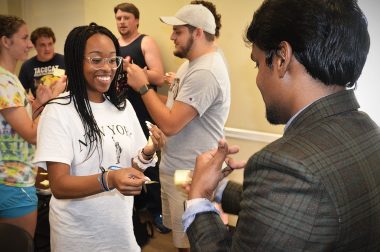Elon's Department of Computer Science has introduced the Game Design Minor, a multidisciplinary program that teaches students to study, design and implement computer games.
As gaming continues to grow in popularity worldwide, Elon’s Department of Computer Science is teaching students to take advantage of the trend.
New for the 2019-20 academic year, the department has introduced the Game Design Minor, a multidisciplinary program that teaches students to study, design and implement computer games. The minor is open to students of all backgrounds, which Assistant Professor of Computer Science Pratheep Kumar Paranthaman says is necessary.
“If you look at the game design industry, it’s not just about programming,” Paranthaman said. “There are various layers to it, such as art designers who design characters, programmers who give life to those characters, and then there are people who design the storyboard. Various departments like art, music, history and computer sciences work together to produce a game.”
For that reason, faculty members from Elon’s Art, Music, English departments and School of Communications also contribute to the minor’s curriculum.
The Game Design Minor, designed by Associate Professor of Computer Science Shannon Duvall, consists of four courses: Game Design, Computer Game Production, and Collaborative Game Development I and II.

Paranthaman is teaching Game Design during the fall semester. The entry-level course teaches students the vocabulary, mechanics and theory of design. It includes a heavy focus on the foundations of game development, so much so students don’t even use computers in the course.
“Computers are just a supplement to the games,” Paranthaman said. “Games existed even before computers came into existence. I mean, backgammon is 5,000 years old. So, we want students to be able to create games just on the fly. If I put them inside of a bush, they should be able to create a game within the bush, given the environment, given the scenario, they shouldn’t have any limitations.”
The goal, Paranthaman says, is to introduce students to the “game design pipeline,” the process of brainstorming, prototyping, play testing and refining a game.

Paranthaman’s students got firsthand experience with the pipeline during a recent class. Using standard classroom items like markers and index cards, students were tasked with creating a game and presenting it to classmates for feedback. Bella Roy ’23 and her group created a competitive memory card game. Roy plans to major in computer science and says the peer feedback she receives in the class will help with her future coursework and the career that follows.
“It’s really important because nothing is going to be perfect on the first try and having a fresh pair of eyes look at it helps you improve it,” she said. “So when someone plays it, they see problems that you didn’t see when you were making it. It really helps you improve.”
After testing and refining their games in class, students concluded the session by playing and analyzing the Nintendo Switch game Super Smash Bros. Ultimate to learn about the tactics and themes professional designers use to create competitive video games. Paranthaman hopes these exercises will help students take a new approach to gaming.

“By the end of the course, students will see games in a different perspective,” he said. “They will be able to see games in two different lenses: one from the viewpoint of the player and one from the viewpoint of designers.”
Once students complete the Game Design course, they learn about the tools required to program a computer game in Computer Game Production. And, in Collaborative Game Development I and II, students put their knowledge to the test, building their own games.
For Computer Science majors, the Game Design Minor is closely related to CSC 435: Game Programming, which teaches students game development foundations, as well as the creation of artificial intelligence and augmented reality gaming.
The goal of broadening game design offerings at Elon is to teach students, not only about design, but also about problem-solving.
“I think it’s really interesting because it covers dynamics that you wouldn’t cover in other classes,” said Pablo Mejido ’22. “It helps you take different looks at a situation and think, ‘What can I make from this?'”
But above all, the Game Design Minor is meant to show the value of teamwork.
“It’s not about your individual contribution,” Paranthaman said. “It’s about what you’re doing as a team. You won’t be able to create a game all on your own. You have to work as part of a team, and that’s what this course is all about.”



